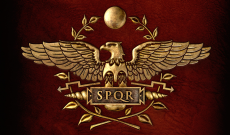
Nearly two thousand years ago in 753 BC the wolf baby Romulus is said to have founded the city of Rome, uniting the Latin tribes in the nearby hills surrounding the river Tiber and making himself King of Rome having killed his brother Remus. Although this is all Roman legend and we have very little source material to tell us what really happened in the very beginnings of the greatest Empire ever known to mankind, we do know from archaeology and some ancient records that there was civilzation in Rome around the date 753BC and that there were seven kings before the Roman Republic was formed, the first (Romulus) and last ( Tarquin Superbus) being most important of the seven. When Rome was founded it was a little settlement and some argue that it consisted largely of refugees from Troy so it had to rely largely on the Etruscans to the North or Greeks to the South. For whatever reason the Romans chose to distance themselves from the Greek owned areas of Southern Italy and Sicily (known then as Magna Graecia - Great Greece) and instead allowed large Etruscan influence in their settlement of Rome. Many of the things we consider to be very Roman came in fact from the Etruscan influence such as the great gladiator games and the iconic great pillars and collums of Roman buildings. However in 510/509 BC the Roman people who were now a substantial size in a large city felt abused by the tyrranical Etruscan Kings and when King Tarquin Superbus' son disgraced and murdered an innocent lady named Lucretia there was a great uprising and the monarchy was abolished.

The people of Rome saw that an attempt at democracy in Athens had failed and that Monarchy also failed so they took both concepts and created an oligarchy which they named the Roman Republic or in Latin Senātus Populusque Rōmānus (SPQR, The Senate and People of Rome). It is a rather complicated political tree but it involved a senate of intellectual men who would discuss urgent matters for Rome (much like the House of Commons today) and two Consuls at its head who made the decisions and acted like leaders. However there were deliberately two so that no single man could have too much power and become a tyrannical king and each individual could also only be consul once and for a one year term, again to prevent power mongering. This system sounds ideal but is rather complicated and you will learn more if you study Rome at degree level but until it was exploited this seemed like a sensible system. The way the Romans took two people's ideas (the Etruscans and Greeks) and improved on them is very characteristic of Rome; their greatest strength was that they were very capable of taking ideas from other nations and then improving on them. A great example of this is that they copied the Greek Phalanx method of battle but improved on it creating the Roman Testudo, an inpenetrable wall of shields that won them many decisive military victories. They also learnt much from the Etruscans about blacksmithing and pottery and improved on their methods, putting the newforged steel to use when they overthrew the Estruscans and took their land. Despite the greatness of Rome as we know it the early years of the Roman Republic began a little more quietly and it actually took some 250 years to secure the Italian peninsula before the Roman Republic turned to conquering other nations, and it would be another several hundred years before the mighty Dictator Julius Caesar and his Nephew, Octavian (Augustus Caesar) the first Roman Emperor.
IMAGE 1: http://www.joergspielt.de/wp-content/uploads/rome2_spqr.jpg
IMAGE 2: http://www.corbisimages.com/images/Corbis-CJ008772.jpg?size=67&uid=405c9d73-8845-4999-990a-ece5722937b3

0 Comment:
Be the first one to comment on this article.